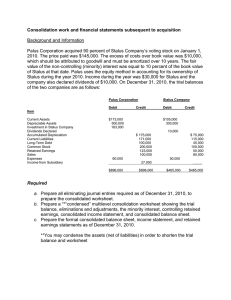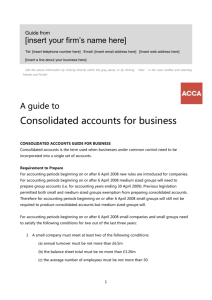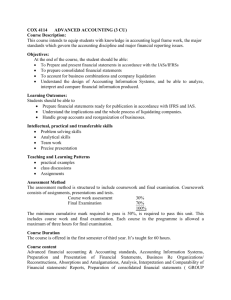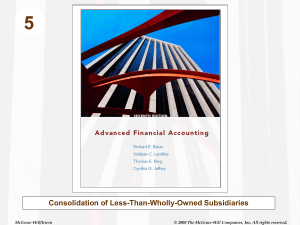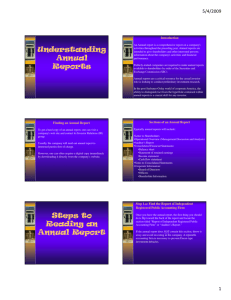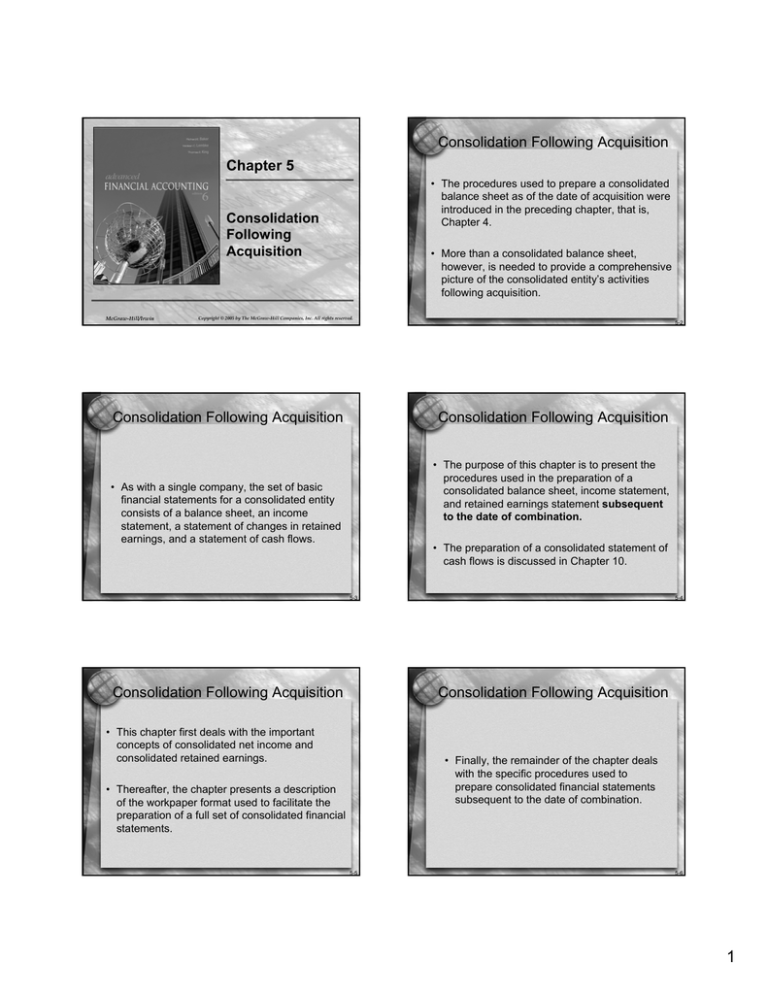
Consolidation Following Acquisition
Chapter 5
• The procedures used to prepare a consolidated
balance sheet as of the date of acquisition were
introduced in the preceding chapter, that is,
Chapter 4.
Consolidation
Following
Acquisition
McGraw-Hill/Irwin
• More than a consolidated balance sheet,
however, is needed to provide a comprehensive
picture of the consolidated entity’s activities
following acquisition.
Copyright © 2005 by The McGraw-Hill Companies, Inc. All rights reserved.
Consolidation Following Acquisition
5-2
Consolidation Following Acquisition
• The purpose of this chapter is to present the
procedures used in the preparation of a
consolidated balance sheet, income statement,
and retained earnings statement subsequent
to the date of combination.
• As with a single company, the set of basic
financial statements for a consolidated entity
consists of a balance sheet, an income
statement, a statement of changes in retained
earnings, and a statement of cash flows.
• The preparation of a consolidated statement of
cash flows is discussed in Chapter 10.
5-3
Consolidation Following Acquisition
5-4
Consolidation Following Acquisition
• This chapter first deals with the important
concepts of consolidated net income and
consolidated retained earnings.
• Finally, the remainder of the chapter deals
with the specific procedures used to
prepare consolidated financial statements
subsequent to the date of combination.
• Thereafter, the chapter presents a description
of the workpaper format used to facilitate the
preparation of a full set of consolidated financial
statements.
5-5
5-6
1
Consolidation Following Acquisition
Consolidation Following Acquisition
• The discussion in the chapter focuses on
procedures for consolidation when the parent
company accounts for its investment in
subsidiary stock using the equity method.
• Regardless of the method used by the parent
to account for its subsidiary investment (during
the year), however, the consolidated statements
will be the same because the investment and
related accounts are eliminated in the
consolidation process.
• If the parent accounts for its investment using
the cost method, the general approach to the
preparation of consolidated financial statements
is the same, but the specific procedures differ
somewhat.
5-7
5-8
Consolidated Net Income
Overview of the Consolidation Process
• The approach followed to prepare a complete
set of consolidated financial statements
subsequent to a business combination is quite
similar to that used to prepare a consolidated
balance sheet as of the date of combination.
• When all subsidiaries are wholly owned by
the parent, all income of the parent and its
subsidiaries accrues to the shareholders of
the parent company.
• In this case, consolidated net income is the
difference between consolidated revenue and
expenses.
• However, in addition to the assets and liabilities,
the revenues and expenses of the consolidating
companies must be combined.
5-9
Consolidated Net Income
5-10
Computing Consolidated Net Income
• When a subsidiary is less than wholly owned, a
portion of its income accrues to its noncontrolling
shareholders and is excluded from consolidated
net income.
• For example, if a parent owns 80 percent of the
common stock of a subsidiary, and the
subsidiary earns net income of $100,000, 80
percent of the income accrues to the parent and
the remaining $20,000, that is 20 percent, is
allocated to the noncontrolling interest.
• Consolidated net income, in simple cases, is
equal to the total earnings for all companies
consolidated, less any income recorded by the
parent from the consolidating companies and
any income assigned to noncontrolling
shareholders.
• Intercorporate investment income included in
the parent’s net income must be removed in
computing consolidated net income in order
to avoid double counting.
5-11
5-12
2
Additive Approach
Additive Approach
• Consolidated net income is computed through
an additive approach by adding together the
parent’s income from its own operations (i.e.,
excluding any income from consolidated
subsidiaries recognized by the parent) and the
parent’s proportionate share of the net income of
each subsidiary adjusted to differential write-off,
where appropriate.
• This is the same approach used to compute
the parent’s equity-method net income.
• In the absence of unrealized profits from
intercompany transactions, consolidated net
income and the parent’s equity-method net
income are normally equal.
5-13
Residual Approach
5-14
Consolidated Retained Earnings
• Consolidated retained earnings is that portion of
the undistributed earnings of the consolidated
enterprise accruing to the shareholders of the
parent company.
• In the workpaper to prepare a complete set of
consolidated financial statements, consolidated
net income is determined using a residual
approach.
• As with a single company, ending consolidated
retained earnings is equal to the beginning
consolidated retained earnings balance plus
consolidated net income, less consolidated
dividends.
• The revenues and expenses of the separate
consolidating companies are included, and
those elements that should not be included are
eliminated.
5-15
Consolidated Retained Earnings
5-16
Consolidated Retained Earnings
• Only those dividends paid to the owners of the
consolidated entity can be included in the
consolidated retained earnings statement.
• In the absence of unrealized profits from
intercompany transactions and goodwill
impairment, consolidated retained earnings
and the parent’s equity-method retained
earnings are normally equal.
• Because the owners of the parent company are
considered to be the owners of the consolidated
entity, only dividends paid by the parent
company to its shareholders are treated as a
deduction in the consolidated retained earnings
statement; dividends of the subsidiary are not
included.
• If the parent uses the equity method on its
books, the retained earnings of each subsidiary
is completely eliminated when the subsidiary is
consolidated.
5-17
5-18
3
Workpaper Format
Workpaper Format
• The basic format of the workpaper is the same
as the workpaper used in the preceding chapter,
that is, Chapter 4.
• A number of different workpaper formats for
preparing consolidated financial statements
are used in practice.
• However, rather than supporting the
development of a consolidated balance sheet,
the workpaper introduced in this chapter also
supports the development of a consolidated
retained earnings statement, as well as a
consolidated income statement.
• One of the most widely used formats is the
three-part workpaper, consisting of one part
for each of three basic financial statements:
the income statement, the statement of
retained earnings, and the balance sheet.
5-19
Workpaper Format
5-20
Workpaper Format
• Information in the workpaper flows from top to
bottom (and from left to right).
• The top portion of the workpaper is used in
preparing the consolidated income statement.
• Consolidated Income must be calculated first in
order that consolidated ending retained earnings
may be calculated.
• The middle portion of the workpaper is used
in preparing the consolidate retained earnings
statement.
• Consolidated ending retained earnings must be
calculated in order to prepared the consolidated
balance sheet.
• The bottom portion of the workpaper is used
to prepare the consolidated balance sheet.
5-21
Need for Workpaper
5-22
Need for Workpaper
• Each of the consolidated financial statements is
prepared as if taken from a single set of books
that is being used to account for the overall
consolidated entity.
• The account balances from the books of the
individual companies are placed in the three-part
workpaper, and entries are made to eliminate
the effects of intercorporate ownership and
transactions.
• There is, of course, no set of books for the
consolidated entity, and as in the preparation of
the consolidated balance sheet, the
consolidation process starts with the data
recorded on the books of the individual
consolidating companies.
5-23
5-24
4
Workpaper Elimination Entries
Workpaper Elimination Entries-Cont’d
• For periods subsequent to the purchase of a
subsidiary, workpaper elimination entries are
needed to:
• Eliminate intercompany receivables and
payables.
• Assign any differential to specific assets
and liabilities.
• Eliminate the parent’s intercorporate
investment balance and the stockholders’
equity accounts of the subsidiary.
• Amortize or write off a portion of a
differential, if appropriate.
• Eliminate income from the subsidiary
recognized by the parent during the period
and dividends declared by the subsidiary.
[Continued on next slide.]
• In addition, if a noncontrolling interest exists,
the noncontrolling shareholders’ claim on the
income and net assets of the subsidiary must
be recognized.
5-25
Discontinuance of Consolidation
5-26
Discontinuance of Consolidation
• A subsidiary that previously has been
consolidated but no longer meets the conditions
for consolidation normally must be reported as
an investment under the cost method in the
consolidated financial statements.
• APB 20 requires financial statements of all prior
periods presented for comparative purposes to
be restated to exclude from the consolidation the
nonqualifying subsidiary and to reflect the new
reporting entity.
• For example, if a previously consolidated
subsidiary declared bankruptcy and the
appointment of a receiver by the courts
prevented the parent from exercising control, the
subsidiary would not quality for consolidation.
• In addition, the financial statements for the
period of the change must disclose if the change
is material, the nature of the change and the
reason for it, and the effect of the change on
income before extraordinary items, net income,
and related per share amounts.
5-27
5-28
Disposal of Differential-Related Assets
Disposal of Differential-Related Assets
• When a subsidiary disposes of an asset, it
recognizes a gain or loss on the disposal equal
to the difference between the proceeds received
and the book value of the asset given up.
• The unamortized portion of a positive purchase
differential that applies to the asset sold or
written off must be treated under the equity
method as a reduction of both the parent’s
income from the subsidiary and the investment
account.
• If the asset is one to which a differential is
assigned in the consolidation workpaper, both
equity-method income recorded by the parent
and consolidated net income are affected.
• In consolidation, the unamortized part of the
purchase differential must be recognized as an
adjustment to the gain or loss on the disposal
of the asset.
5-29
5-30
5
Inventory
FIFO Inventory
• When FIFO inventory costing is used by the
subsidiary, the inventory units on hand on the
date of combination are viewed as being the
first units sold after the combination.
• Any inventory-related differential is assigned
to inventory for as long as the inventory units
are held by the subsidiary.
• In the period in which the inventory units are
sold, the inventory-related differential is
assigned to cost of goods sold.
• Therefore, the differential normally is assigned
to cost of goods sold in the period immediately
after the combination.
5-31
LIFO Inventory
5-32
Fixed Assets
• A purchase differential related to land held by
a subsidiary is added to the land balance in
the consolidation workpaper each time a
consolidated balance sheet is prepared.
• When the subsidiary uses LIFO inventory
costing, the inventory units on the date of
combination are viewed as remaining in the
subsidiary’s inventory.
• If the subsidiary sells the land to which the
differential relates, the differential is treated in
the consolidation workpaper as an adjustment
to the gain or loss on the sale of the land in the
period of the sale.
• Only if the inventory level drops below the level
at the date of combination is a portion of the
differential assigned to cost of goods sold.
5-33
Differential Assigned to Liabilities
5-34
Differential Assigned to Liabilities
• With the considerable swings in interest rates
over the past decade, companies often find that
liabilities assumed in a business combination
have fair values different from their book values.
• The differential arising from a liability should be
amortized similar to the amortization of a bond
premium or bond discount, as applicable.
• As with assets acquired, liabilities assumed in a
purchase-type combination must be valued at
their fair values. Thus, a portion of the
differential arising in the consolidation
workpaper often relates to liabilities.
5-35
5-36
6
You Will Survive This Chapter !!!
Chapter 5
• You can’t own yourself !
End of Chapter
• You can’t owe money to yourself !
• You can’t make money selling to yourself !
5-37
McGraw-Hill/Irwin
Copyright © 2005 by The McGraw-Hill Companies, Inc. All rights reserved.
7

